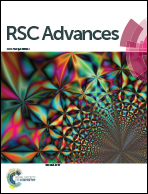Fabrication of superwetting, antimicrobial and conductive fibrous membranes for removing/collecting oil contaminants
Abstract
In order to remove/collect organic contaminants from polluted water, polypyrrole/silver nanoparticles (PPy/Ag NPs) have been loaded onto spandex fabric using the method of in situ redox-oxidation polymerization to achieve a specific membrane. Observations showed that the original hydrophobic fabric became superhydrophilic and superoleophobic underwater (with an underwater oil contact angle (OCA) of 160°). The as-prepared specimen could effectively remove the oil from an oil-in-water emulsion. After further hydrophobic modification, the specimen was transformed into a fabric that possessed durable superhydrophobicity and superlipophilicity (with a water contact angle (WCA) of 159°), which could collect the oil from a water-in-oil emulsion. Apparently, the two types of fibrous membranes completely satisfied the conditions for removing/collecting organic contaminants from opposite types of water/oil mixtures. The durable evaluation results exhibited the outstanding resistance of both fibrous membranes to friction and acidic and basic scouring agents. Additionally, the multifunctional fabric membrane also possessed excellent electrical conductivity and antibacterial activities towards S. aureus, B. subtilis, and E. coli, which will greatly promote developments in the textile industry and provide a bright future for fabric-based materials.



 Please wait while we load your content...
Please wait while we load your content...